护理专业期末试题(英语)1
- 格式:doc
- 大小:68.50 KB
- 文档页数:6
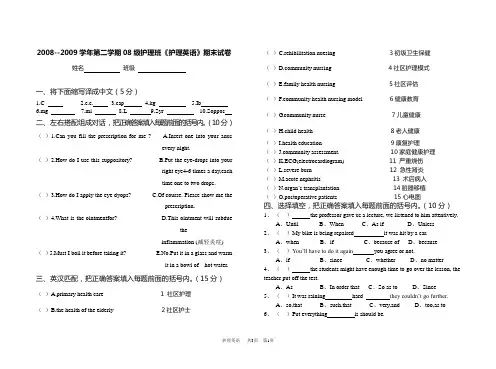
2008--2009学年第二学期08级护理班《护理英语》期末试卷姓名班级一、将下面缩写译成中文(5分)1.C2.c.c.3.cap4.kg5.Ib6.mg7.ml8.L9.Syr 10.Soppos二、左右搭配组成对话,把正确答案填入每题前面的括号内。
(10分)()1.Can you fill the prescription for me ? A.Insert one into your anusevery night.()2.How do I use this suppository? B.Put the eye-drops into yourright eye4-6 times a day,eachtime one to two drops.()3.How do I apply the eye dyops? C.Of course. Please show me theprescription.()4.What is the ointmentfor? D.This ointment will subduetheinflammation (减轻炎症) ()5.Must I boil it before taking it? E.No.Put it in a glass and warmit in a bowl of hot water.三、英汉匹配,把正确答案填入每题前面的括号内。
(15分)()A.primary health care 1 社区护理()B.the health of the elderly 2社区护士()C.rehibilitation nuesing 3初级卫生保健()munity nursing 4社区护理模式()E.family health nursing 5社区评估()munity health nursing model 6健康教育()munity nurse 7儿童健康()H.child health 8老人健康()I.health education 9康复护理()munity assessment. 10家庭健康护理()K.ECG(electrocardiogram) 11 严重烧伤()L.severe burn 12 急性肾炎()M.acute nephritis 13 术后病人()an’s transplantation 14脏器移植()O.postoperative patients 15心电图四、选择填空,把正确答案填入每题前面的括号内。
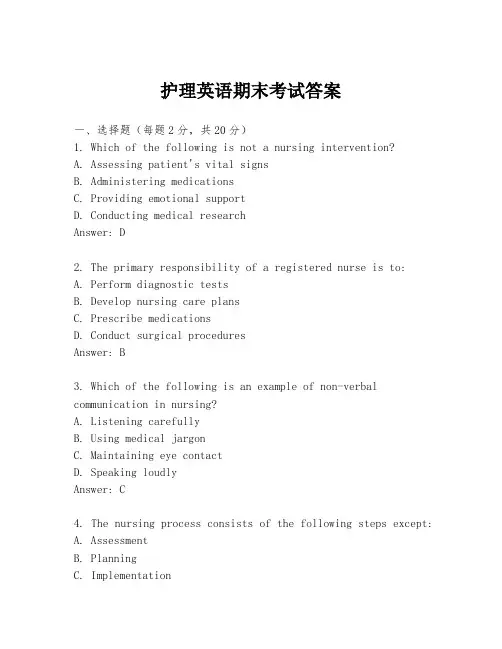
护理英语期末考试答案一、选择题(每题2分,共20分)1. Which of the following is not a nursing intervention?A. Assessing patient's vital signsB. Administering medicationsC. Providing emotional supportD. Conducting medical researchAnswer: D2. The primary responsibility of a registered nurse is to:A. Perform diagnostic testsB. Develop nursing care plansC. Prescribe medicationsD. Conduct surgical proceduresAnswer: B3. Which of the following is an example of non-verbal communication in nursing?A. Listening carefullyB. Using medical jargonC. Maintaining eye contactD. Speaking loudlyAnswer: C4. The nursing process consists of the following steps except:A. AssessmentB. PlanningC. ImplementationD. EvaluationE. ReflectionAnswer: E5. Which of the following is not a principle of infection control?A. Hand hygieneB. Use of personal protective equipmentC. Isolation of infected patientsD. Sharing needles among patientsAnswer: D6. The acronym "ABC" in emergency care stands for:A. Airway, Breathing, CirculationB. Assessment, Breathing, CirculationC. Assessment, Blood pressure, CirculationD. Airway, Blood pressure, CirculationAnswer: A7. A nursing diagnosis is:A. A medical diagnosis given by a physicianB. A clinical judgment about an individual's response to health conditionsC. A nursing intervention to treat a health problemD. A nursing outcome to be achievedAnswer: B8. The purpose of a nursing care plan is to:A. Document the patient's medical historyB. Provide a guide for nursing interventionsC. List all possible nursing diagnosesD. Record the results of nursing interventionsAnswer: B9. Which of the following is not a component of the nursing assessment?A. Health historyB. Physical examinationC. Laboratory testsD. Patient's financial statusAnswer: D10. The Maslow's hierarchy of needs includes the following levels except:A. Physiological needsB. Safety needsC. Esteem needsD. Moral needsAnswer: D二、填空题(每题1分,共10分)1. The first step in the nursing process is _assessment_.2. A nursing diagnosis should be stated in terms of_etiology_ and _defining characteristics_.3. The acronym _PQRST_ is used to assess a patient's pain.4. _Hand hygiene_ is the most effective way to prevent the spread of infection.5. The nursing intervention of _positioning_ can help prevent skin breakdown.6. _Aseptic technique_ is used to maintain a sterile environment during invasive procedures.7. The nursing outcome related to patient education is oftenreferred to as _patient teaching_.8. _Documentation_ is essential for legal and continuity of care purposes.9. The nursing process involves a systematic approach to the delivery of _patient-centered care_.10. _Evidence-based practice_ involves using the best available research evidence in conjunction with clinical expertise to guide nursing practice.三、简答题(每题5分,共20分)1. Describe the role of a nurse in a multidisciplinary healthcare team.Answer: A nurse in a multidisciplinary healthcare team acts as a patient advocate, coordinates care, communicates effectively with team members, and provides direct patient care based on nursing assessments and care plans.2. Explain the importance of cultural competence in nursing practice.Answer: Cultural competence in nursing practice is important because it enables nurses to provide patient-centered care that respects and incorporates the cultural values, beliefs, and practices of diverse patient populations. This leads to improved patient satisfaction, better health outcomes, and reduced health disparities.3. What are the key components of a nursing care plan? Answer: The key components of a nursing care plan include a comprehensive patient assessment, nursing diagnoses, goals and expected outcomes, nursing interventions, and evaluation of the effectiveness of the care provided.4. Discuss the significance of evidence-based practice in nursing.Answer: Evidence-based practice in nursing is significant as it promotes the use of current, best research evidence in conjunction with clinical expertise and patient preferences to guide nursing decisions. This approach leads to improved patient outcomes, reduced healthcare costs, and enhanced professional nursing practice.结束语:本试题涵盖了护理英语期末考试的核心知识点,旨在帮助学生复习和巩固所学内容。

护理期末英语试题及答案Introduction:As the end of the semester approaches, it is crucial for nursing students to review and assess their knowledge. This article aims to provide a comprehensive set of nursing-related multiple-choice questions along with their corresponding answers. By practicing these questions, students can evaluate their understanding of various nursing concepts, enhance their critical thinking skills, and better prepare themselves for the final exam.Section 1: Anatomy and Physiology1. Which of the following is responsible for filtering waste products from the blood?a. Kidneysb. Liverc. Lungsd. SpleenAnswer: a. Kidneys2. The respiratory system is responsible for:a. Pumping blood throughout the bodyb. Regulating body temperaturec. Transporting oxygen to the cellsd. Producing hormonesAnswer: c. Transporting oxygen to the cellsSection 2: Nursing Fundamentals3. What is the most appropriate way to prevent the spread of infection?a. Washing hands with soap and waterb. Using alcohol-based hand sanitizersc. Wearing gloves at all timesd. Disinfecting surfaces with bleachAnswer: a. Washing hands with soap and water4. Which of the following is the correct sequence for donning personal protective equipment (PPE)?a. Gloves, gown, mask, gogglesb. Gown, gloves, mask, gogglesc. Goggles, gloves, mask, gownd. Mask, goggles, gown, glovesAnswer: b. Gown, gloves, mask, gogglesSection 3: Pharmacology5. As a nurse, you have administered a medication to a patient. What is the essential action you should take afterwards?a. Document the administration of the medicationb. Inform the patient about potential side effectsc. Dispose of any leftover medicationsd. Assess the patient's vital signsAnswer: a. Document the administration of the medication6. What is the term used to describe a drug's desired effect on the body?a. Side effectb. Generic namec. Therapeutic effectd. Adverse reactionAnswer: c. Therapeutic effectSection 4: Medical-Surgical Nursing7. A patient with diabetes is admitted to the hospital with high blood glucose levels. What intervention should the nurse prioritize?a. Administering insulin as orderedb. Providing pain medication for discomfortc. Assisting the patient with ambulationd. Ensuring a balanced dietAnswer: a. Administering insulin as ordered8. Which of the following is a potential complication of immobility in hospitalized patients?a. Increased muscle strengthb. Improved circulationc. Pressure ulcersd. Enhanced lung functionAnswer: c. Pressure ulcersSection 5: Mental Health Nursing9. A patient with depression is exhibiting signs of isolation and withdrawal. The nurse should prioritize which action?a. Encouraging social interactionsb. Administering antidepressant medicationc. Promoting physical activityd. Educating the patient about coping skillsAnswer: a. Encouraging social interactions10. What is the nurse's role in promoting suicide prevention?a. Providing counseling servicesb. Assessing for risk factorsc. Administering psychotropic medicationsd. Conducting therapy sessionsAnswer: b. Assessing for risk factorsConclusion:The above set of nursing-related multiple-choice questions covers various aspects of the nursing curriculum, including anatomy and physiology, nursing fundamentals, pharmacology, medical-surgical nursing, and mental health nursing. By reviewing and practicing these questions, nursing students can assess their knowledge and readiness for the final exam. Remember, continuous learning and practice are key to becoming a knowledgeable and competent nurse. Good luck with your studies and the upcoming examination!。
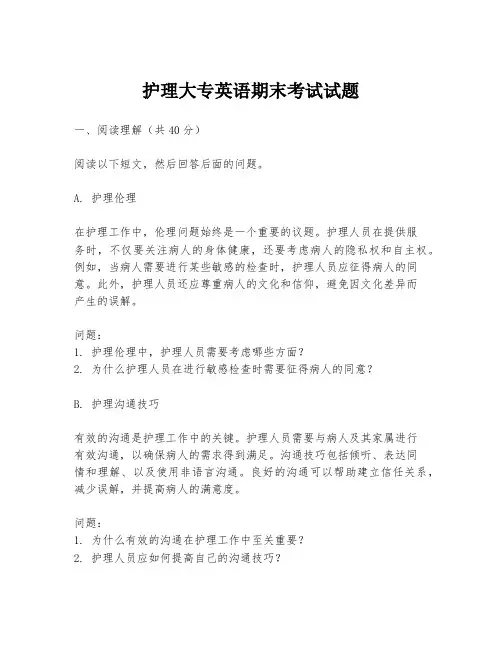
护理大专英语期末考试试题一、阅读理解(共40分)阅读以下短文,然后回答后面的问题。
A. 护理伦理在护理工作中,伦理问题始终是一个重要的议题。
护理人员在提供服务时,不仅要关注病人的身体健康,还要考虑病人的隐私权和自主权。
例如,当病人需要进行某些敏感的检查时,护理人员应征得病人的同意。
此外,护理人员还应尊重病人的文化和信仰,避免因文化差异而产生的误解。
问题:1. 护理伦理中,护理人员需要考虑哪些方面?2. 为什么护理人员在进行敏感检查时需要征得病人的同意?B. 护理沟通技巧有效的沟通是护理工作中的关键。
护理人员需要与病人及其家属进行有效沟通,以确保病人的需求得到满足。
沟通技巧包括倾听、表达同情和理解、以及使用非语言沟通。
良好的沟通可以帮助建立信任关系,减少误解,并提高病人的满意度。
问题:1. 为什么有效的沟通在护理工作中至关重要?2. 护理人员应如何提高自己的沟通技巧?二、词汇与语法(共30分)词汇填空:1. The nurse should always respect the patient's ________ (隐私) and confidentiality.2. It is important for nurses to communicate ________ (有效) with patients to understand their needs.语法改错:1. The patient was very anxious, so the nurse comfort himwith a gentle voice.2. The nurse must to respect the patient's cultural background and beliefs.三、翻译(共20分)将下列句子从英文翻译成中文:1. The nurse should always be aware of the ethicalimplications of their actions.2. Communication is a vital part of nursing practice, and itis essential for nurses to develop good communication skills.四、写作(共10分)题目:作为一名护理专业的学生,你如何看待护理工作中的伦理问题?要求:请写一篇不少于100字的短文,表达你的观点。

2022年护理英语期末考试题一、听力第一节(共5小题,每小题1分)听下面5段对话。
每段对话后有一个小题,从题中所给的A、B、C三个选项中选出最佳选项,并标在试卷的'相应位置。
听完每段对话后,你都有10秒钟的时间来回答有关小题和阅读下一小题。
每段对话仅读一遍。
1、Who is the man talking about now?A.His girlfriend.B.His sister.C.His mother.2、What are they talking about?A.A traffic accident.B.A fire.C.A crime.3、Where does the conversation most probably take place?A.At a bookshop.B.At a kitchen.C.At a bank.4、Who was injured?A.George.B.George’s wife.C.George’s wife’s father.5、What do we learn from the conversation?A.Tony could not continue the experiment.B.Tony finished the experiment last night.C.Tony will go on with his experiment.第二节(共15小题,每小题1分)听下面5段对话或独白。
每段对话或独白后有几个小题,从题中所给的A、B、C三个选项中选出最佳选项,并标在试卷的相应位置。
听每段对话或独白前,你将有时间阅读各个小题,每小题5秒钟;听完后,各小题将给出5秒钟的作答时间。
每段对话或独白读两遍。
听第6段材料,回答第6至7题。
6、Where does this conversation most likely take place?A.In the street.B.At the woman’s home.C.Over the phone.7、What is the woman going to do tonight?A.Help her sister with English.B.Meet her friend at the station.C.Go to an exhibition with her parents.听第7段材料,回答第8至10题。

护理专业英语试题及答案一、选择题(每题1分,共10分)1. The term "nursing" is derived from the Latin word "nutrire," which means:A. to feedB. to healC. to careD. to teach答案:A2. Which of the following is a fundamental principle of nursing ethics?A. AutonomyB. ConfidentialityC. BeneficenceD. All of the above答案:D3. The abbreviation "IV" stands for:A. IntravenousB. In vitroC. In vivoD. International Vitamin答案:A4. A patient's "vital signs" typically include:A. Temperature, pulse, and respirationB. Blood pressure, pulse, and respirationC. Temperature, blood pressure, and respirationD. All of the above答案:B5. The abbreviation "BP" refers to:A. Blood pressureB. Blood productC. Body partD. Both A and B答案:A6. The "NANDA" in nursing is an acronym for:A. National Association for Nursing Development and AdvancementB. North American Nursing Diagnosis AssociationC. Nursing and Diagnostics for Advanced NursingD. None of the above答案:B7. What does "ADL" stand for in the context of nursing?A. Activities of Daily LivingB. Acute Disease LifeC. Advanced Diagnostic LaboratoryD. All of the above答案:A8. The "5 Rights" of medication administration refer to:A. Right patient, right drug, right dose, right time,right routeB. Right diagnosis, right drug, right time, right route, right outcomeC. Right patient, right drug, right diagnosis, right time, right outcomeD. Right patient, right time, right dose, right route, right documentation答案:A9. The "PQRST" method is used to assess:A. PainB. RespirationC. TemperatureD. Pulse答案:A10. The "ABCs" of CPR stand for:A. Airway, Breathing, CirculationB. Assessment, Breathing, CirculationC. Airway, Blood pressure, CirculationD. All of the above答案:A二、填空题(每空1分,共10分)1. The primary goal of nursing is to promote __________ and prevent disease.答案:health2. A nursing diagnosis must be based on a thorough __________ of the patient's condition.答案:assessment3. The "Maslow's Hierarchy of Needs" includes five levels, with the most basic level being __________.答案:physiological needs4. The nursing process consists of five steps: assessment, diagnosis, __________, implementation, and evaluation.答案:planning5. Infection control practices are crucial to prevent the spread of __________ in healthcare settings.答案:infection6. The term "anergy" in medical terms refers to a lack of__________.答案:response7. The abbreviation "PRN" stands for __________.答案:pro re nata8. The "Brady" in "Bradycardia" means __________.答案:slow9. A nursing intervention that involves the use of touch isknown as __________.答案:therapeutic touch10. The "SBAR" technique is a structured format for communication in nursing, where "S" stands for __________.答案:situation三、简答题(每题5分,共20分)1. What are the key components of a nursing care plan?答案:A nursing care plan typically includes the patient's assessment, nursing diagnosis, goals, interventions, and evaluation of outcomes.2. Explain the difference between "acute care" and "chronic care" in nursing.答案:Acute care focuses on the immediate and short-term treatment of severe injuries or illnesses, while chronic care involves long-term management and support for patients with ongoing health conditions.3. Describe the role of a registered nurse (RN) in a healthcare team.答案:A registered nurse assesses patient needs, develops and implements nursing care plans, coordinates patient care, and collaborates with other healthcare professionals to ensure quality patient care.4. What is the significance of cultural competence in nursing practice?答案:Cultural competence in nursing is important forproviding patient-centered care that respects and incorporates the cultural。
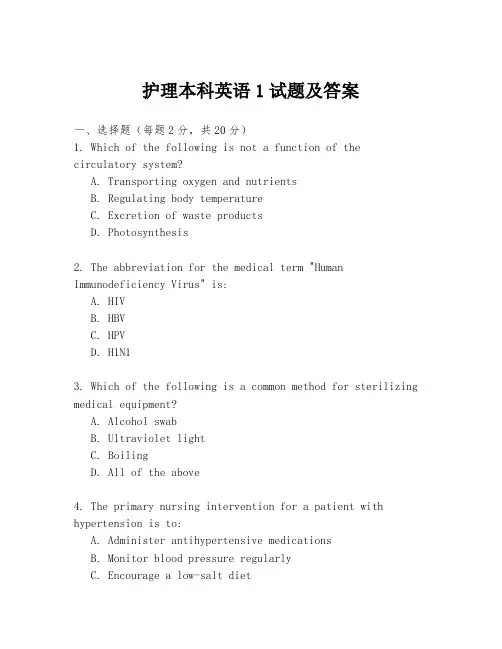
护理本科英语1试题及答案一、选择题(每题2分,共20分)1. Which of the following is not a function of the circulatory system?A. Transporting oxygen and nutrientsB. Regulating body temperatureC. Excretion of waste productsD. Photosynthesis2. The abbreviation for the medical term "Human Immunodeficiency Virus" is:A. HIVB. HBVC. HPVD. H1N13. Which of the following is a common method for sterilizing medical equipment?A. Alcohol swabB. Ultraviolet lightC. BoilingD. All of the above4. The primary nursing intervention for a patient with hypertension is to:A. Administer antihypertensive medicationsB. Monitor blood pressure regularlyC. Encourage a low-salt dietD. Restrict physical activity5. The "Five Rights" of safe medication administration include:A. Right patient, right drug, right dose, right time, right routeB. Right patient, right drug, right dose, right method, right documentationC. Right patient, right drug, right dose, right route, right documentationD. Right patient, right drug, right time, right route, right documentation6. Infection control practices include all of the following except:A. Hand hygieneB. Use of personal protective equipment (PPE)C. Patient isolationD. Sharing needles among patients7. The most common method for measuring a patient's body temperature is:A. OralB. RectalC. AxillaryD. Tympanic8. Which of the following is not a vital sign?A. PulseB. RespirationC. Blood pressureD. Pain level9. The "ABCs" of emergency response refer to:A. Airway, breathing, and circulationB. Airway, blood pressure, and circulationC. Ambulation, breathing, and circulationD. Assessment, breathing, and circulation10. The purpose of aseptic technique is to:A. Prevent the spread of diseaseB. Ensure patient privacyC. Maintain a clean work environmentD. Manage patient pain二、填空题(每题2分,共20分)11. The normal range for an adult's respiratory rate is__________ to __________ breaths per minute.12. When performing a bed bath for a patient, the nurse should __________ the patient's skin to prevent skin breakdown.13. The three golden rules for hand hygiene are:_____________, _____________, and _____________.14. The most common site for intravenous catheter insertion is the __________.15. The nursing process consists of five steps: assessment, diagnosis, planning, __________, and evaluation.16. A patient's medication regimen should be reviewed for__________ and effectiveness.17. The primary goal of pain management is to __________ the patient's pain to a tolerable level.18. The side-lying position is often used to promote__________ in patients with respiratory issues.19. The principle of asepsis requires that sterile items are __________ from non-sterile items.20. The two types of patient restraints are physical and__________.三、简答题(每题10分,共20分)21. Explain the difference between active and passive immunity.22. Describe the steps a nurse should take when administering an intramuscular injection.四、阅读理解(每 question 10分,共20分)23. Read the following case study and answer the question below:[Case Study]A 45-year-old male patient is admitted to the hospital with a diagnosis of type 2 diabetes. The patient reports feeling fatigued and experiencing frequent urination. His current medications include metformin and glipizide. The nurse notes that the patient's last blood glucose reading was 14.2 mmol/L.Question: What nursing interventions would be appropriate for this patient?24. Read the following passage and answer the question below: [Passage]Palliative care is specialized medical care for people with serious illnesses. It focuses on providing patients with relief from the symptoms and stress of a serious illness—without necessarily addressing the underlying disease. The goal is to improve quality of life for both the patients and their families.Question: What is the primary aim of palliative care?五、写作题(20分)25. Write an essay on the importance of communication in nursing practice. Your essay should be at least 200 words and discuss the following points:- The role of effective communication in building trust with patients- How communication can。
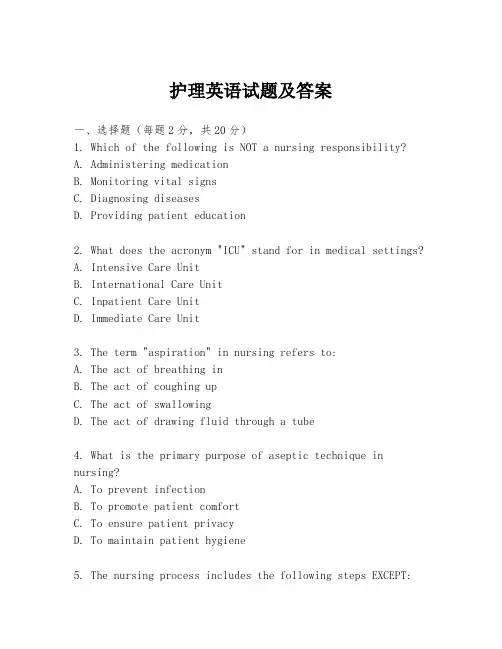
护理英语试题及答案一、选择题(每题2分,共20分)1. Which of the following is NOT a nursing responsibility?A. Administering medicationB. Monitoring vital signsC. Diagnosing diseasesD. Providing patient education2. What does the acronym "ICU" stand for in medical settings?A. Intensive Care UnitB. International Care UnitC. Inpatient Care UnitD. Immediate Care Unit3. The term "aspiration" in nursing refers to:A. The act of breathing inB. The act of coughing upC. The act of swallowingD. The act of drawing fluid through a tube4. What is the primary purpose of aseptic technique in nursing?A. To prevent infectionB. To promote patient comfortC. To ensure patient privacyD. To maintain patient hygiene5. The nursing process includes the following steps EXCEPT:A. AssessmentB. PlanningC. ImplementationD. Documentation6. Which of the following is an example of a non-pharmacological intervention?A. Administering antibioticsB. Applying heat or cold therapyC. Prescribing anti-inflammatory drugsD. Providing intravenous fluids7. The abbreviation "BP" commonly used in nursing refers to:A. Blood pressureB. Blood productC. Blood pressure cuffD. Blood purification8. Which of the following is a nursing intervention for pain management?A. Administering pain medicationB. Providing a quiet environmentC. Both A and BD. None of the above9. What is the meaning of "NPO" in medical terms?A. No pain observedB. Nothing by mouthC. Not permitted to operateD. No physical operation10. The "5 Rights" of medication administration in nursing include:A. Right patient, right drug, right dose, right time, right routeB. Right patient, right drug, right dose, right place, right recordC. Right patient, right drug, right dose, right time, right recordD. Right patient, right drug, right dose, right route, right record二、填空题(每空1分,共10分)1. The nursing process involves a systematic approach to provide care, which includes ________, ________, ________,and ________.2. In nursing, the term "ADL" stands for Activities of Daily Living, which refers to the basic tasks individuals performin their daily lives, such as ________, ________, and________.3. The abbreviation "PRN" in nursing means "Pro Re Nata," which is used to indicate medication should be given ________.4. A nursing diagnosis is a clinical judgment about an individual's response to a health problem, which includes the identification of an actual or potential health problem that may be addressed through ________.5. The nursing intervention "Elevate" refers to the act of________ a body part to reduce swelling or improvecirculation.三、简答题(每题5分,共20分)1. Explain the concept of "Patient-Centered Care" in nursing.2. Describe the role of a nurse in the prevention ofhospital-acquired infections.3. What are the steps involved in the process of wound care?4. Discuss the importance of effective communication in nursing practice.四、案例分析题(每题15分,共30分)1. A patient has been admitted to the hospital with a diagnosis of pneumonia. The nurse is responsible for administering antibiotics and monitoring the patient's response to treatment. What are the key nursing considerations for this patient?2. A patient is scheduled for surgery tomorrow. The nurse is preparing the patient for preoperative care. What are the essential components of preoperative teaching that the nurse should provide to the patient?五、论述题(共20分)Discuss the role of a nurse in promoting health and preventing disease in the community. Include specific strategies and interventions that can be implemented.答案:一、选择题1. C2. A3. D4. A5. D6. B7. A8. C9. B 10. A二、填空题1. Assessment, Diagnosis, Outcome Identification, Planning2. Eating, Dressing, Bathing3. When necessary4. Nursing care5. Raising三、简答题1. Patient-Centered Care is an approach to care that focuses on the needs, preferences, and values of the patient, ensuring that care is tailored to the individual's unique circumstances and promotes active participation in their health care.2. The role of a nurse in preventing hospital-acquired infections includes implementing infection control measures, educating patients and staff about hygiene practices, and monitoring for signs of infection.。
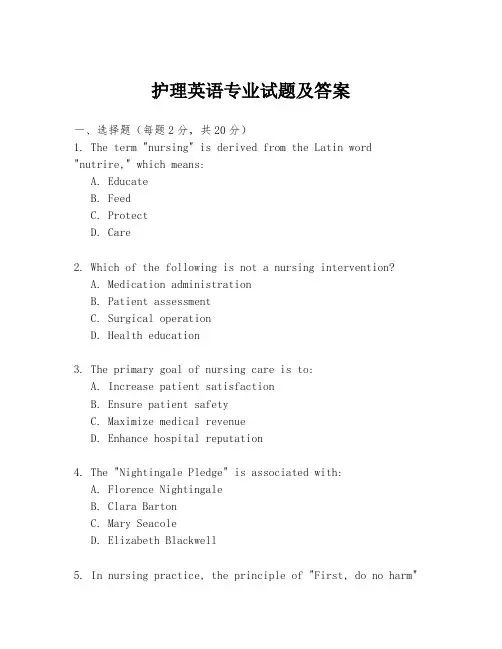
护理英语专业试题及答案一、选择题(每题2分,共20分)1. The term "nursing" is derived from the Latin word "nutrire," which means:A. EducateB. FeedC. ProtectD. Care2. Which of the following is not a nursing intervention?A. Medication administrationB. Patient assessmentC. Surgical operationD. Health education3. The primary goal of nursing care is to:A. Increase patient satisfactionB. Ensure patient safetyC. Maximize medical revenueD. Enhance hospital reputation4. The "Nightingale Pledge" is associated with:A. Florence NightingaleB. Clara BartonC. Mary SeacoleD. Elizabeth Blackwell5. In nursing practice, the principle of "First, do no harm"is known as:A. AutonomyB. BeneficenceC. Non-maleficenceD. Justice6. A nurse should wash their hands:A. Before and after patient contactB. Only after patient contactC. Only before patient contactD. Neither before nor after patient contact7. The nursing process includes the following steps except:A. AssessmentB. PlanningC. DocumentationD. Surgery8. The acronym "ABC" in emergency situations stands for:A. Airway, Breathing, CirculationB. Assessment, Breathing, CirculationC. Assessment, Blood pressure, CirculationD. Airway, Blood pressure, Circulation9. Which of the following is a nursing theory?A. Maslow's Hierarchy of NeedsB. Freud's Psychoanalytic TheoryC. Piaget's Theory of Cognitive DevelopmentD. Skinner's Theory of Operant Conditioning10. The role of a nurse in patient advocacy includes:A. Enforcing hospital rulesB. Protecting patient rightsC. Ignoring patient complaintsD. Prioritizing medical staff needs答案:1. D2. C3. B4. A5. C6. A7. D8. A9. A10. B二、填空题(每空1分,共10分)1. The four cardinal signs of infection are fever, pain, redness, and _______.2. The nursing diagnosis should be based on a comprehensive _______ of the patient.3. The nursing care plan should include the patient's name, diagnosis, nursing diagnosis, goals, interventions, and_______.4. The nursing process is a systematic approach that includes assessment, diagnosis, planning, implementation, and _______.5. The principle of _______ in nursing practice ensures that the patient's rights and dignity are respected.6. The nursing role in health promotion includes education, counseling, and _______.7. The "Nightingale Pledge" is a commitment to uphold the ethical standards and professional responsibilities of_______.8. Infection control measures include hand hygiene, use of personal protective equipment, and _______.9. The nursing care of a patient with a urinary catheter should include regular assessment of the catheter site for signs of _______.10. The nurse's role in pain management includes assessment, documentation, and administration of _______ as prescribed.答案:1. swelling2. assessment3. evaluation4. evaluation5. beneficence6. screening7. nursing8. disinfection9. infection10. analgesics三、简答题(每题5分,共20分)1. What are the core competencies of a nurse?2. Explain the concept of "holistic nursing care."3. Describe the steps involved in the nursing process.4. Discuss the importance of cultural competence in nursing.答案:1. The core competencies of a nurse include communication,critical thinking, clinical judgment, ethical reasoning, and leadership.2. Holistic nursing care is an approach that considers the physical, emotional, social, and spiritual needs of the patient, aiming to provide comprehensive care that respectsthe patient's individuality.3. The steps involved in the nursing process are assessment, diagnosis, planning, implementation, and evaluation.4. Cultural competence in nursing is important as it enables nurses to provide care that is sensitive to the cultural beliefs, values, and practices of diverse patient populations, thereby promoting patient-centered care and reducing health disparities.四、案例分析题(每题15分,共30分)1. A patient is admitted to the hospital with a diagnosis of pneumonia. The nurse notes that the patient is experiencing shortness of breath, fever, and chest pain. What。
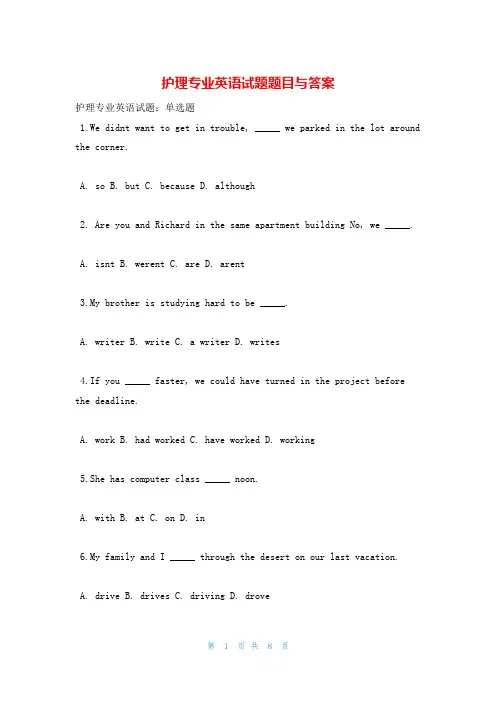
护理专业英语试题题目与答案护理专业英语试题:单选题1.We didnt want to get in trouble, _____ we parked in the lot around the corner.A. soB. butC. becauseD. although2. Are you and Richard in the same apartment building No, we _____.A. isntB. werentC. areD. arent3.My brother is studying hard to be _____.A. writerB. writeC. a writerD. writes4.If you _____ faster, we could have turned in the project before the deadline.A. workB. had workedC. have workedD. working5.She has computer class _____ noon.A. withB. atC. onD. in6.My family and I _____ through the desert on our last vacation.A. driveB. drivesC. drivingD. drove7._____ time do you spend on your homework every dayA. How muchB. How wellC. How oftenD. How long8.What programs _____ He mostly uses Microsoft Word and Excel.A. is he usingB. does he useC. he usedD. he use9.Since they changed jobs, their life _____ been much easier.A. areB. wasC. hasD. had10.Is that Martins new car Yes, its _____.A. himB. himselfC. hisD. he11.What television shows did you watch when you were a child I _____ watch comedies.A. wasB. likedC. used toD. did12.My _____ usually goes to the office on foot.A. best friendB. best friendsC. best friend sheD. best friend is13.If we _____ some more money, we could go away this weekend.A. are havingB. haveC. hadD. would have14.We went to the doctor _____ she couldnt seem to get rid of her cold.A. soB. forC. thatD. because15.The secretary asked me _____ I wanted to meet with.A. whoB. howC. whyD. when16.If you feel full, dont _____ any more of that pizza.A. ateB. eatingC. eatD. eats17.I forgot my keys on the desk. _____ giving me a lift homeA. Could youB. Can youC. Will youD. Would you mind18.My classmates and I enjoy doing similar things. _____ favorite activity is going cycling.A. OurB. WeC. UsD. They19.Amy lives in Thailand now. She _____ at a large university there.A. teachB. taughtC. is teachingD. teaching20.She always gets good evaluations. She must be _____ employee inthe company.A. the most valuableB. more valuableC. the valuableD. valuable21.Has he ever _____ to swimA. learnedB. learnC. learningD. learns22.When I last saw them, my sisters were on their way _____ the mall.A. onB. inC. atD. to23.I want to send the Smiths an email. Do you have _____ email addressA. theyB. themC. theirD. there24.The movie was over before we had time _____ the plot.A. for understandB. to understandC. understandingD. understand25._____ was a big parade in front of the university campus.A. TheirB. TheyC. TheseD. There26.My teacher was living in Dubai when she _____ her future husband.A. will meetB. metC. was meetingD. meets27.Before _____ a decision on what to order, John asked the waiter for hisrecommendation.A. makeB. madeC. makingD. being made28.There isnt _____ milk left. I need to go out and get some.A. manyB. someC. noD. any29.If you dont slow down, you _____ have a heart attack.A. wouldB. willC. canD. should30.The project was _____ complicated than they had expected.A. soB. mostC. moreD. too31.My father is a surgeon. _____ works in a hospital.A. ItB. FatherC. HeD. She32.If you _____ eating so much junk food, youll lose weight.A. stoppedB. stopC. might stopD. are stopping33. A 65-year-old male is admitted to your unit. He says, My wife and I have notbeen apart for 45 years. Your best response would beA. It must be difficult for you to be separated from her.B. Your wife will be able to visit you every day.C. Youll be fine once you get adjusted to the hospital routine.D. Your time in the hospital will pass very quickly.34. A client recently diagnosed with lung cancer says to the nurse, Im still going tosmoke. The nurses best response to this client would beA. I cant believe you would still want to smoke.B. When did you start smokingC. Lets talk more about this.D. Im sure your family will be upset.35. A client brought to the emergency department appears veryanxious and tearful.The nurses best response would beA. Im sure you have been in the hospital before.B. There is really nothing to worry about.C. I know this is frightening for you.D. The hospital really isnt so bad.36. A newborn died from an intraventricular hemorrhage(颅内出血). Which of the following responses would be most appropriate for the nurse to make to the motherA. Well at least your baby is with God now and is not suffering from braindamage.B. Would you like for me to be with you while your hold your babyC. I know that it does not seem possible right now, but you can get pregnantagain.D. Just try to think about how wonderful your pregnancy was.37. Which of the following statements, if made by a patient who has terminal cancer,demonstrates the stage of bargaining as described in the theory of death and dyingA. I know Im going to get better.B. I have put my financial affairs in order.C. I do not understand why this happened to me.D. I plan to be around until my grandsons graduation.38. A nurse is assessing the stoma(人造孔) of a client after a urethrostomy(尿道造口术). Which of the following would the nurse expect to noteA.Pale.B.Red and moist.C.Dry.D.Dark-colored.。
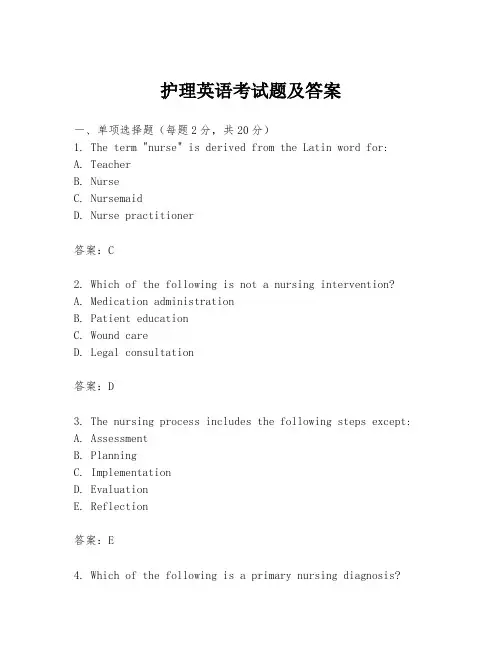
护理英语考试题及答案一、单项选择题(每题2分,共20分)1. The term "nurse" is derived from the Latin word for:A. TeacherB. NurseC. NursemaidD. Nurse practitioner答案:C2. Which of the following is not a nursing intervention?A. Medication administrationB. Patient educationC. Wound careD. Legal consultation答案:D3. The nursing process includes the following steps except:A. AssessmentB. PlanningC. ImplementationD. EvaluationE. Reflection答案:E4. Which of the following is a primary nursing diagnosis?A. InfectionB. ConstipationC. AnxietyD. Impaired skin integrity答案:C5. The acronym "PQRST" is used to assess:A. PainB. Sleep patternsC. Bowel movementsD. Vital signs答案:A6. The "ABCs" of nursing assessment refer to:A. Airway, Breathing, CirculationB. Activities of daily living, Blood pressure, Cognitive functionC. Assessment, Body systems, Care planD. Ambulation, Blood sugar, Catheters答案:A7. A nursing care plan is developed based on:A. The patient's medical diagnosisB. The patient's nursing diagnosesC. The patient's cultural backgroundD. The patient's age答案:B8. Which of the following is not a nursing outcome?A. Relief of painB. Improved mobilityC. Decreased anxietyD. Increased blood pressure答案:D9. The nursing action of "positioning" is intended to:A. Enhance patient comfortB. Prevent skin breakdownC. Facilitate breathingD. All of the above答案:D10. The term "evidence-based practice" in nursing refers to:A. Using the latest research findings to guide patient careB. Following traditional nursing practicesC. Relying on personal experienceD. Using intuition to make clinical decisions答案:A二、填空题(每空1分,共10分)1. The nursing process begins with a(n) __________ of the patient's health status.答案:assessment2. A(n) __________ nursing diagnosis is one that can beinfluenced by nursing actions.答案:intervenable3. The acronym "SOAP" in nursing documentation stands for Subjective, Objective, __________, and __________.答案:Assessment, Plan4. The nursing intervention of "ambulation" is aimed at promoting __________ and preventing __________.答案:mobility, complications5. The nursing action of "monitoring" involves __________ and __________ the patient's condition.答案:observing, recording三、简答题(每题10分,共20分)1. Explain the importance of cultural competence in nursing practice.答案:Cultural competence in nursing practice is crucial as it enables nurses to provide patient-centered care that respects and acknowledges the cultural beliefs, values, and practices of the individuals they serve. It promoteseffective communication, reduces health disparities, and enhances patient satisfaction and outcomes.2. Describe the role of a nurse in promoting patient safety. 答案:A nurse plays a vital role in promoting patient safety by implementing safety protocols, conducting regular risk assessments, educating patients and their families on safety measures, advocating for safe practices, and reporting any safety concerns or incidents to ensure a safe environment forall patients.结束语:本套护理英语考试题及答案旨在评估考生对护理专业英语知识的掌握程度,希望考生通过本次考试能够进一步巩固和提升自己的专业英语能力。
大专版护理英语期末试卷期末考试系大专护理英语试卷班级__________ 姓名学号说明:全卷满分 100 分。
考试用时 90分钟。
一.选择题,四个选项中只有一个为正确答案,请将正确答案写在相应位置。
(每题2分,共40分)1,Frank is the ________ of a business company.A directorB headmasterC superiorD leader2, He saved money, so he had to _________.A spare itB economiseC keep itD rescue it3, Spare parts for aeroplanes are made in Frank’s _________.A industryB fabricC factoryD workhouse4, He was still smiling when the door opened and his wife_________.A went inB entered inC enteredD entered into5, The man was rowing, so he was using _________.A rowsB sticksC oarsD rudders6, Some people on the bank ________ the man.A criedB cried withC cried forD cried to7, The man in the boat didn’t _______ anyone shouting.A hearB listen toC mindD take care of8, The ball _______ him very hard.A knocked atB beatC bouncedD hit9, They had run away, so they had ________.A dismissedB disturbedC displacedD disappeared10, It’s an usually taxi. It isn’t very________.A accustomedB commonC usuallyD used to11, The ploughed field is ready for_______.A sewingB sowingC seedingD growing12, It’s a lonely village. It is _______.A farB far from anywhereC aloneD the only one13, The car park was deserted. It was________.A a desertB emptyC abandonedD wasted14, He is a rare person. You ________ meet such people.A oftenB neverC seldomD sometimes15, Not all car owners are good _______.A guidesB conductorsC leadersD drivers16, You can see some _________ outside his gate. They say “No Parking”A labelsB noticesC signalsD notes17, The signals haven’t had any effect. They haven’t _______ anyone.A affectedB effectedC resulted inD imposed18, They cooked a meal because they wanted to _______.A sing songsB tell storiesC playD eat19, They crept into their tent, so they ______.A made a lot of noiseB ran quicklyC were very quietD were very noisy20, They slept soundly. They slept ______.A noisilyB fastC deeplyD good二. 填空, 用括号中动词的正确形式填空。
护理英语考试题目和答案一、选择题(每题2分,共20分)1. Which of the following is the correct way to address a patient in English?A. Hey, youB. Sir/MadamC. Patient XD. DudeAnswer: B. Sir/Madam2. What is the English term for "体温"?A. Blood pressureB. PulseC. TemperatureD. RespirationAnswer: C. Temperature3. Which of the following is not a nursing intervention?A. Medication administrationB. Patient educationC. Bed makingD. Surgical operationAnswer: D. Surgical operation4. The abbreviation "IV" stands for:A. IntravenousB. Invasive ventilationC. In VitroD. In VivoAnswer: A. Intravenous5. What is the English term for "血压"?A. Blood sugarB. Blood pressureC. Blood testD. Blood lossAnswer: B. Blood pressure6. Which of the following is a nursing assessment tool?A. StethoscopeB. ThermometerC. SphygmomanometerD. All of the aboveAnswer: D. All of the above7. The abbreviation "NPO" stands for:A. Nothing by mouthB. No pain observedC. No physical obstructionD. Not permitted to operateAnswer: A. Nothing by mouth8. What is the English term for "脉搏"?A. PulseB. Blood pressureC. TemperatureD. RespirationAnswer: A. Pulse9. Which of the following is not a nursing responsibility?A. Patient careB. DocumentationC. ResearchD. Building constructionAnswer: D. Building construction10. The abbreviation "PRN" stands for:A. Pro re nataB. Per rectumC. Per osD. Per requestAnswer: A. Pro re nata二、填空题(每题2分,共20分)1. The English term for "护士" is _________.Answer: nurse2. "脉搏" in English is _________.Answer: pulse3. The abbreviation "BP" stands for _________.Answer: blood pressure4. "体温" in English is _________.Answer: temperature5. The English term for "输液" is _________.Answer: infusion6. The abbreviation "PO" stands for _________.Answer: per os7. "血压" in English is _________.Answer: blood pressure8. The English term for "病人" is _________.Answer: patient9. The abbreviation "IM" stands for _________.Answer: intramuscular10. "呼吸" in English is _________.Answer: respiration三、简答题(每题10分,共40分)1. What are the main responsibilities of a nurse in a hospital setting?Answer: The main responsibilities of a nurse in a hospital setting include providing direct patient care, administering medications, monitoring vital signs, assisting withdiagnostic tests, educating patients and their families, maintaining patient records, and collaborating with other healthcare professionals to ensure quality patient care.2. Explain the difference between "infection control" and "infection prevention".Answer: Infection control refers to the measures taken to manage and limit the spread of infections within healthcare settings after an infection has occurred. This may involve isolation of infected patients, use of personal protective equipment, and environmental cleaning. Infection prevention, on the other hand, focuses on proactive strategies to prevent the occurrence of infections in the first place. This includes vaccination, hand hygiene, and adherence to aseptic techniques.3. What are the key components of a nursing assessment?Answer: The key components of a nursing assessment include a comprehensive history, physical examination, and psychosocial evaluation. This involves gathering information about the patient's medical history, current symptoms, lifestyle, family history, and emotional well-being. The physical examination includes assessing vital signs, skin, head, eyes, ears, nose, throat, chest, abdomen, musculoskeletal system, and neurological system. The psychosocial evaluation assesses the patient's mental health, social support, and coping mechanisms.4. Describe the nursing process and its stages.Answer: The nursing process is a systematic approach to providing nursing care. It consists of five stages: assessment, diagnosis, planning, implementation, and evaluation. Assessment involves gathering information about the patient's health status. Diagnosis is the identification of nursing problems based on the assessment data. Planning involves setting goals and developing a care plan to address the identified problems. Implementation is the execution of the care plan, including providing nursing interventions. Evaluation is the ongoing assessment of the patient's response to the interventions and the effectiveness of the care plan.结束语:希望以上题目和答案能帮助你更好地复习和。
医护英语试题及答案一、选择题(每题2分,共20分)1. What is the most common method of transmission for the common cold?A. AirborneB. FoodborneC. Direct contactD. Vector-borne答案:A2. Which of the following is not a vital sign?A. TemperatureB. PulseC. RespirationD. Blood pressure答案:C3. The abbreviation "IV" stands for:A. IntravenousB. IntramuscularC. IntraperitonealD. Intrathecal答案:A4. What does "ICU" refer to in a hospital setting?A. Intensive Care UnitB. Inpatient Care UnitC. International Care UnitD. Intermittent Care Unit答案:A5. Which of the following is a symptom of anemia?A. FatigueB. High feverC. Excessive sweatingD. Rapid weight gain答案:A6. The term "auscultation" refers to listening to sounds within the body using a:A. StethoscopeB. OtoscopeC. OphthalmoscopeD. Thermometer答案:A7. A patient is said to be in "shock" when:A. They are experiencing severe painB. They are unconsciousC. Their blood pressure is significantly lowD. They have a high fever答案:C8. What is the purpose of a "suture" in medical terms?A. To provide anesthesiaB. To close a woundC. To remove a foreign objectD. To diagnose a condition答案:B9. The "HCG" test is used to detect:A. DiabetesB. PregnancyC. AnemiaD. Infection答案:B10. Which of the following is a type of imaging technique used in medical diagnostics?A. X-rayB. Blood testC. BiopsyD. Electrocardiogram答案:A二、填空题(每题2分,共20分)1. The medical term for a broken bone is ____________.答案:fracture2. A doctor's written instructions for the use of medication are called a ____________.答案:prescription3. The process of removing a damaged or diseased organ is called ____________.答案:surgery4. The study of the causes and control of diseases is known as ____________.答案:epidemiology5. A ____________ is a healthcare professional who specializes in the care of patients with mental disorders.答案:psychiatrist6. The medical term for a surgical incision is ____________. 答案:incision7. The ____________ is the part of the hospital where critically ill patients are treated.答案:intensive care unit8. A ____________ is a healthcare professional who provides care to patients in their homes.答案:nurse9. The ____________ is a medical device used to measure blood pressure.答案:sphygmomanometer10. The term ____________ refers to the process of removing a patient's blood for analysis.答案:blood draw三、简答题(每题10分,共40分)1. Explain the difference between a "nurse" and a "nurse practitioner".答案:A nurse is a healthcare professional who provides care to patients under the supervision of a physician. A nurse practitioner (NP) is an advanced practice registered nurse who has completed additional education and training, allowingthem to diagnose and treat patients, prescribe medications, and often act as a primary care provider.2. Describe the role of a "physician assistant" in a medical setting.答案:A physician assistant (PA) is a healthcare professional who practices medicine under the supervision of a physician. They can perform physical exams, diagnose and treat illnesses, order and interpret tests, assist in surgery, and prescribe medications.3. What is the purpose of a "dialysis" treatment?答案:Dialysis is a medical treatment that removes waste products and excess fluids from the blood when the kidneysare unable to do so. It is used to treat patients with kidney failure or severe kidney disease.4. Explain the concept of "informed consent" in medical procedures.答案:Informed consent is the process by which a patient is given information about a medical procedure or treatment, including its risks and benefits, and then voluntarily agrees to undergo the procedure. It is a fundamental ethicalprinciple in healthcare that ensures the patient's autonomy and right to make decisions about their own medical care.。
护士英文测试题及答案1. What is the term used to describe the process of assessinga patient's health status?A. DiagnosisB. AssessmentC. TreatmentD. EvaluationAnswer: B. Assessment2. Which of the following is not a basic principle of nursing care?A. Holistic careB. Patient autonomyC. ConfidentialityD. Punitive measuresAnswer: D. Punitive measures3. What is the primary goal of nursing practice?A. To maximize the patient's comfortB. To promote health and prevent diseaseC. To provide only medical treatmentsD. To ensure the patient's compliance with ordersAnswer: B. To promote health and prevent disease4. Which of the following is an example of a nursingintervention?A. Prescribing medicationB. Performing surgeryC. Administering a medicationD. Diagnosing a diseaseAnswer: C. Administering a medication5. What is the term for the process of prioritizing nursing care based on the urgency and importance of the patient's needs?A. Nursing care planningB. Nursing care prioritizationC. Nursing care implementationD. Nursing care evaluationAnswer: B. Nursing care prioritization6. Which of the following is not a component of the nursing process?A. AssessmentB. PlanningC. ImplementationD. DocumentationAnswer: D. Documentation7. What is the term used to describe the act of providing care to a patient based on a nursing diagnosis?A. Nursing interventionB. Nursing assessmentC. Nursing evaluationD. Nursing planningAnswer: A. Nursing intervention8. Which of the following is a nursing responsibility?A. To perform all medical proceduresB. To provide physical care and emotional supportC. To make medical diagnosesD. To prescribe medicationsAnswer: B. To provide physical care and emotional support9. What is the term for the process of evaluating the effectiveness of nursing care?A. Nursing assessmentB. Nursing evaluationC. Nursing planningD. Nursing implementationAnswer: B. Nursing evaluation10. Which of the following is not a nursing role?A. EducatorB. CounselorC. ResearcherD. SurgeonAnswer: D. Surgeon。
护理考试试题卷答案英语一、选择题(每题2分,共20分)1. Which of the following is the most common method of transmission for infectious diseases?A. Airborne transmissionB. Foodborne transmissionC. Vector-borne transmissionD. Direct contact transmissionAnswer: A2. The primary nursing intervention for a patient with a high fever is to:A. Administer antibioticsB. Encourage fluid intakeC. Apply cold compressesD. Administer antipyreticsAnswer: D3. The purpose of hand hygiene in nursing practice is to:A. Enhance patient satisfactionB. Prevent the spread of infectionC. Improve hand strengthD. Facilitate wound healingAnswer: B4. Which of the following is not a nursing responsibility?A. Assessing patient needsB. Administering medicationsC. Performing diagnostic testsD. Providing patient educationAnswer: C5. The nursing process begins with:A. PlanningB. ImplementationC. EvaluationD. AssessmentAnswer: D6. The most important aspect of patient-centered care is:A. The patient's medical historyB. The patient's physical conditionC. The patient's preferences and valuesD. The patient's family involvementAnswer: C7. When administering medications, the nurse should:A. Double-check the medication labelB. Ignore the patient's allergiesC. Rush to administer the medicationD. Administer the medication in the darkAnswer: A8. The nursing diagnosis "Impaired skin integrity" is related to:A. InfectionB. Chronic illnessC. Acute injuryD. All of the aboveAnswer: D9. The nursing intervention for a patient with constipation should include:A. Encouraging bed restB. Administering a laxativeC. Increasing fluid intakeD. Decreasing fiber intakeAnswer: C10. The most effective way to prevent pressure ulcers is:A. Frequent repositioningB. Using a soft mattressC. Applying topical ointmentsD. Keeping the skin dryAnswer: A二、填空题(每空1分,共10分)1. The nursing process consists of five steps: assessment, diagnosis, planning, implementation, and _______.Answer: evaluation2. The acronym for the nursing process is _______.Answer: ADPIE3. The first step in the nursing process is _______ the patient's needs.Answer: assessing4. A nursing diagnosis is a _______ statement that describesa patient's health problem.Answer: clinical5. The primary goal of nursing care is to promote thepatient's _______.Answer: health6. Hand hygiene is crucial in preventing the spread of_______.Answer: infection7. The nursing intervention for a patient with pain should focus on _______ the pain.Answer: relieving8. The nursing diagnosis "Risk for infection" is used when the patient is at risk for developing an _______.Answer: infection9. The nursing intervention for a patient with impaired mobility should include _______ the patient's safety. Answer: ensuring10. The nursing intervention for a patient with a risk of falling should include _______ the environment.Answer: modifying三、简答题(每题10分,共20分)1. Explain the importance of effective communication in nursing practice.Answer: Effective communication is crucial in nursing practice as it allows nurses to accurately assess patients' needs, provide appropriate care, and educate patients about their health conditions. It also helps in building trust and rapport with patients, which is essential for promoting patient satisfaction and adherence to treatment plans.2. Describe the role of a nurse in promoting patient safety. Answer: A nurse plays a vital role in promoting patient safety by assessing patients for potential risks, implementing safety measures, and educating patients about safety precautions. Nurses also advocate for patients, ensuring that their needs are met and that they receive appropriate care. Additionally, nurses participate in quality improvement initiatives to identify and address safety concerns within the healthcare setting.结束语:本试题卷涵盖了护理实践中的关键概念和技能,旨在评估考生对护理知识的掌握程度。